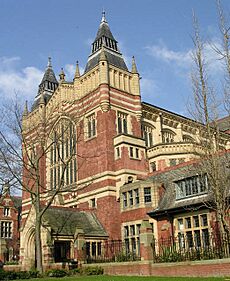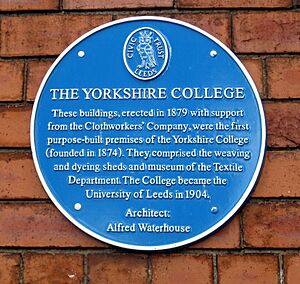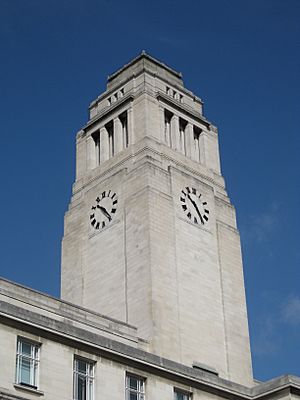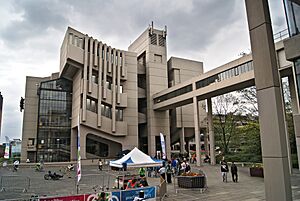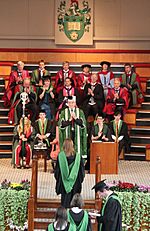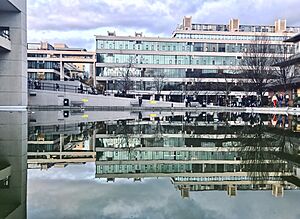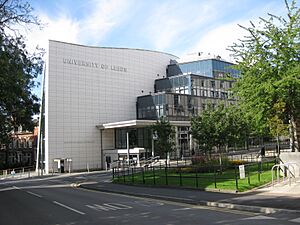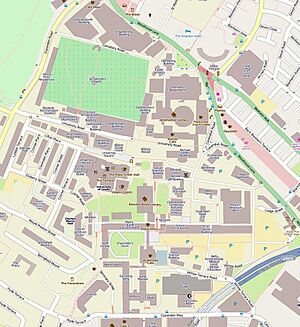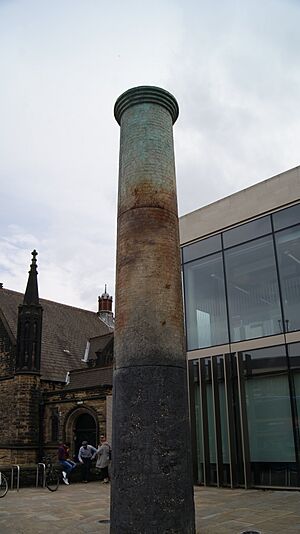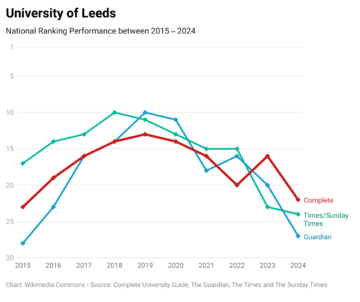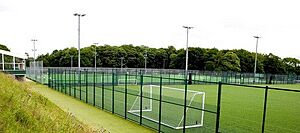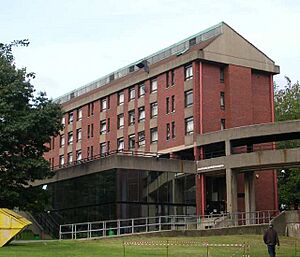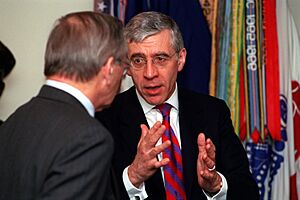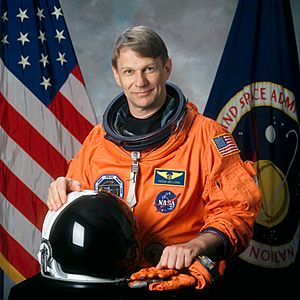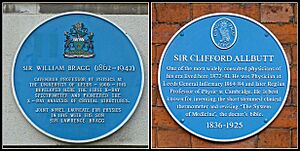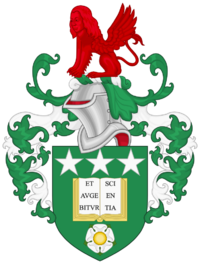University of Leeds facts for kids
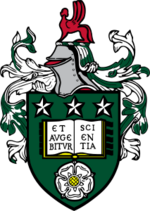
|
|||||||||||||||||
| Motto | Latin: Et augebitur scientia | ||||||||||||||||
|---|---|---|---|---|---|---|---|---|---|---|---|---|---|---|---|---|---|
|
Motto in English
|
And knowledge will be increased | ||||||||||||||||
| Type | Public | ||||||||||||||||
| Established | 1831 – Leeds School of Medicine 1874 – Yorkshire College of Science 1884 – Yorkshire College 1887 – affiliated to the federal Victoria University 1904 – University of Leeds |
||||||||||||||||
| Endowment | £83.2 million (2023) | ||||||||||||||||
| Budget | £979.5 million (2022/23) | ||||||||||||||||
| Chancellor | Jane Francis | ||||||||||||||||
| Vice-Chancellor | Hai-Sui Yu (interim) | ||||||||||||||||
|
Academic staff
|
3,760 (2021/22) | ||||||||||||||||
|
Administrative staff
|
4,995 (2021/22) | ||||||||||||||||
| Students | 37,190 (2021/22) | ||||||||||||||||
| Undergraduates | 27,015 (2021/22) | ||||||||||||||||
| Postgraduates | 10,175 (2021/22) | ||||||||||||||||
| Location |
,
,
England
53°48′26″N 1°33′6″W / 53.80722°N 1.55167°W |
||||||||||||||||
| Campus | Urban, suburban | ||||||||||||||||
| Newspaper | The Gryphon | ||||||||||||||||
| Colours |
|
||||||||||||||||
| Affiliations |
|
||||||||||||||||
 |
|||||||||||||||||
The University of Leeds is a large public research university in Leeds, West Yorkshire, England. It started in 1874 as the Yorkshire College of Science. In 1884, it joined with the Leeds School of Medicine (which began in 1831). It was then called Yorkshire College.
In 1887, it became part of the bigger Victoria University. This university also included colleges that later became the University of Manchester and the University of Liverpool. In 1904, King Edward VII gave the University of Leeds its own special permission, called a royal charter, to be an independent university.
Leeds is one of the largest universities in the United Kingdom. It gets over 67,000 applications from students each year. This makes it one of the most popular universities in the UK. In 2022–23, the university earned £979.5 million. About £184.9 million of this came from research projects. The university also has £83.2 million in financial gifts (endowments). This places it among the top twenty British universities for financial support.
Many famous people have studied at Leeds. These include Labour Party leader Keir Starmer and NASA astronaut Piers Sellers. Six Nobel Prize winners have also been connected to the university.
Contents
Discovering the University's Past
Early Beginnings
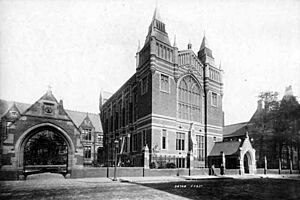
The university's story is linked to Leeds becoming a global hub for making textiles and clothes. The university's roots go back to medical schools created in English cities. These schools helped the public.
The Victoria University was set up in Manchester in 1880. It was a group of universities in the North of England. Owens College was the only college in Victoria University from 1880 to 1884. In 1887, Yorkshire College was the third college to join this group.
How the Leeds School of Medicine and Yorkshire College Started
In 1831, the Leeds School of Medicine was created. Its goal was to serve the five medical places already in the city. In 1874, the Yorkshire College of Science was formed. It aimed to educate children of business owners and traders. Money from local industries was very important for starting the college. It also helped students. The university still remembers this history. For example, there is a Clothworkers' Court on campus.
The College of Science was like Owens College in Manchester. It started in 1851 and welcomed all religions. It was open to Protestant Dissenters, Catholics, and Jews. This was different from Oxford and Cambridge. Those universities only allowed members of the Church of England. University College London also welcomed all religions.
The Yorkshire College of Science first taught physics, maths, geology, and chemistry. It quickly became known for engineering and textile technology. This was because manufacturing and textiles were strong in West Riding. Later, when classics, literature, and history were offered, it became just the Yorkshire College. In 1884, the Yorkshire College took in the Leeds School of Medicine. Then, on November 3, 1887, it joined the Victoria University. Students at this time received degrees from the University of London.
Becoming an Independent University
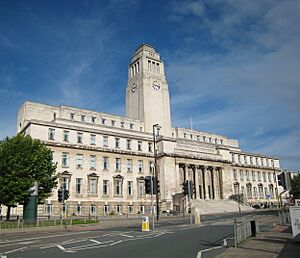
Leeds got its first university status in 1887. This happened when the Yorkshire College joined the Victoria University. This university had been set up in 1880. Owens College was the first member. Leeds then joined an educational group with colleges from Manchester and Liverpool.
The Leeds campus of Victoria University always welcomed women. However, many women started joining in 1896. This was when special facilities were made ready. The first female student was Lilias Annie Clark. She studied Modern Literature and Education. In 1904, Leeds University wanted more women students. It paid a high salary to Hannah Robertson. She worked as a "Mistress of Method" and as a Tutor for Women.
The Victoria (Leeds) University group did not last long. The universities in Manchester and Liverpool wanted to be separate. This was partly because having their own university helped their cities. Also, it was hard to manage a group of universities spread far apart. The University of Birmingham got its own charter in 1900. This encouraged other universities to seek independence.
After a royal charter in 1903, the University of Liverpool became independent. The University of Leeds soon followed. King Edward VII gave Leeds its own royal charter in 1904. This made it an independent university.
From 2000 to Today
The Victoria University continued after the group broke up. It was renamed the Victoria University of Manchester. In October 2004, it joined with another institute. They formed The University of Manchester.
In December 2004, the university decided to close its Bretton campus. All activities from Bretton moved to the main campus in 2007. This allowed students to finish their studies there. Another site in Wakefield also closed. But Lifelong Learning and Healthcare programs still run at a new site.
In May 2006, the university changed its look. It created a new logo. This logo was based on the one used for its 2004 celebrations. The old university arms are now only used for special events. The university also chose four main colors: green, red, black, and beige.
Leeds provides over 2,000 student volunteers to the local community. With 8,700 staff in 2019–20, the university is the third largest employer in Leeds. It adds about £1.23 billion a year to the local economy. Students add another £211 million through rent and living costs.
The university has worked with other colleges. It has given degrees to Leeds College of Art and Leeds Trinity University College. The College of the Resurrection, a religious college, has been linked to the university since 1904. The university is also a founding member of the Northern Consortium.
In August 2010, the university was popular for students using the UCAS clearing process. This process helps students find courses if they didn't get into their first choices. Leeds was one of nine Russell Group universities offering limited places.
In October 2010, the Leeds University Union hosted a live TV show. Students and experts talked about university funding. The university's Vice-Chancellor Michael Arthur took part.
In 2016, the University of Leeds was named "University of the Year 2017." This was by The Times and The Sunday Times Good University Guide. The university moved up to 13th place overall. This showed good results in student experience and job prospects.
In 2022, the University of Leeds was ranked 86th globally. There are about 36,840 students. The average tuition fee is £9,250 per year.
Exploring the Campus
The university owns 1230 acres of land. The main campus covers 98 acres. It is located about 1 mile north of Leeds city centre. The campus has many different building styles. These include Gothic revival, art deco, brutalist, and postmodern buildings. This makes it one of the most varied campuses in the country. It is easy to walk to from the city centre and student areas like Hyde Park. The main entrance for cars is on Woodhouse Lane. The old Woodhouse Cemetery is now a landscaped area called St George's Fields.
Parkinson Building
The Parkinson Building is a famous Grade II listed art deco building. It has a tall tower, called a campanile. It is named after Frank Parkinson, who gave a lot of money to the university. He donated £200,000 for its construction. The building officially opened in 1951. The tower is a well-known landmark in Leeds. It is 57 metres (187 ft) tall. It is the 17th tallest building in the city. The tower is also used in the university's logo.
Maurice Keyworth Building
The Leeds University Business School is in the Maurice Keyworth Building. These are old 19th-century buildings. They used to be Leeds Grammar School. The university also built new modern buildings nearby. These are called the Innovation Hub and cost £9.3 million. This building is three stories high.
Roger Stevens Building
The Roger Stevens building was built in 1970. It is one of the most famous buildings on campus. It is mainly used for lectures.
Great Hall
The university's Great Hall is a very important building. It stands out along with the Parkinson Building. The Great Hall was built on the site of the Beech Grove Hall Estate. The Yorkshire College bought this land in 1879. The old hall was taken down in 1884. Then, the Clothworkers buildings and the Great Hall were built. The famous architect Alfred Waterhouse designed them. They cost £22,000. The Great Hall was the university library for a while. Now, it is used for exams, meetings, and graduation ceremonies.
Buildings from After the War
In June 2010, some post-war buildings at the University of Leeds were recognized as important. English Heritage recommended them to be Grade II listed buildings. These include the Roger Stevens Building, EC Stoner Building, and Edward Boyle Library. These buildings join others already listed. These include the Great Hall and the Parkinson Building.
Besides the main campus, there is also a site in Wakefield. Some courses used to be taught at the Bretton Hall campus. This site closed in 2007. Those courses moved to the main campus.
Leeds railway station is about 1 mile south of the main campus. Many bus routes serve the campus. The proposed Leeds Trolleybus will also pass by the campus. This will connect it to the city centre.
The University of Leeds Conference Auditorium used to be the West Yorkshire Playhouse. It was updated in 2003. Now it has two lecture theatres. One holds 320 people, and the other holds 550. This makes it the largest lecture space on campus.
The university's Muslim Prayer Room is in the Conference Auditorium. It can hold up to 300 people. It was recently updated with half a million pounds.
Modern Campus Growth
The university has been growing since 2008. It has spent over £300 million on new buildings. These include places for learning, research, living, and fun. Another £80 million is being spent to improve existing buildings. This is one of the biggest building projects in British higher education.
- Earth and Environment improvements cost £23 million. They included new labs. These labs opened in April 2009.
- Charles Morris Hall student homes were built. A new 500-bed building costing £27.1 million was finished in 2010.
- The Childcare Centre was completed in April 2010. It is a new 140-place centre for staff and student children.
- Swimming pool and fitness centre (called The Edge) opened in May 2010. This new complex cost £12.2 million.
- The Law Building is a £12 million project. It was finished in early 2011. It is next to the new Michael Marks Building. This building holds the Marks & Spencer archives.
- The Edward Boyle Library had a £28 million update. This work started in 2015 and finished in 2016.
- The Energy Building cost £12.5 million. It makes the engineering area bigger. It was finished in March 2012.
- Clothworkers Building North had a £42.3 million update. This work completely redid the facilities.
Art Around Campus
There are many art pieces on campus. These range from Eric Gill's 1923 war memorial to Simon Fujiwara's 9-meter (30 ft) tall A Spire. This sculpture is outside the Laidlaw Library. Liliane Lijn's 2019 Converse Column is at the campus entrance. The university works with the Contemporary Art Society on its art plan.
What Students Learn and Do
During the 2021-22 school year, 37,190 students were enrolled. In 2009–10, there were about 560 different first-degree programs. There were also about 300 postgraduate programs. Leeds is strong in traditional subjects like languages and sciences. It also has unique areas like Colour Chemistry and Aviation Technology.
Libraries for Learning
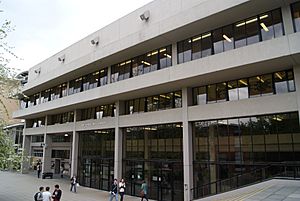
The university library has five locations. It holds 2.78 million books. It also has 26,000 print and electronic journals. This makes it one of the largest research libraries in the UK. The main library for arts and humanities is the Brotherton Library. It is in the Parkinson Building. The main library for science and social sciences is the Edward Boyle Library. It is in the middle of campus. Medical students use the Health Sciences Library. The Laidlaw Library, for undergraduates, opened in May 2015. It is named after Lord Laidlaw, who gave £9 million for its building.
The university library has many old and rare items. These include books and objects from 2,500 BC to today. Its Special Collections has five collections that are considered outstanding. These include English Literature, the Leeds Russian Archive, and the Cookery Collection. It also has a copy of William Shakespeare's First Folio from 1623. There is also a copy of Sir Isaac Newton's Philosophiæ Naturalis Principia Mathematica from 1687.
The Special Collections also holds over 300 early printed books. It has many medieval manuscripts. The coin collection has 15,000 coins and medals. The Feminist Archive North Collections are also here. They have materials about women from 1969 to today.
The Stanley and Audrey Burton Gallery and the Treasures Gallery are managed by Special Collections.
Computers and Technology
IT Services helps the university with many computer services. These are for staff, students, and visitors. Faculties and schools also have computer facilities. The university also uses external Cloud Computing and High Performance Computing facilities.
In 2023, there were 31 main computer study spaces.
The IT Services Research Computing Team helps with research. They provide platforms, advice, and training. There is a special documentation site for High Performance Computing.
Research and Discovery
Many departments have special research facilities. These help staff and students with their research. They range from old collections in libraries to modern labs. For example, the Institute for Transport Studies has a driving simulator. It is one of the most advanced in the world for research. It lets researchers study driver behavior safely.
The university works closely with St James's University Hospital, Leeds. Through the Leeds School of Medicine, it has many high-tech labs. These are for biomedical sciences, food, and engineering. They include clean rooms for bionanotechnology. The university is also linked to Leeds General Infirmary. This helps combine research and medical practice.
The university also has research facilities for aviation. It has an Airbus A320 flight simulator. This simulator helps students learn about flight safety. They practice reacting to problems like engine failure or bad weather.
Many university departments do research in their fields. There are also research centers, like the Leeds University Centre for African Studies.
Medical School Excellence
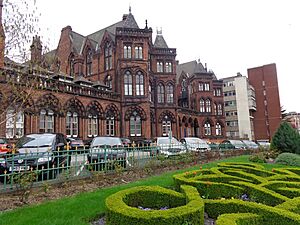
The Leeds School of Medicine is one of the largest medical schools in Europe. It trains over 250 medical students each year. It has over 1,000 staff for teaching and research. The school has special centers. These include the Leeds Institute of Genetics, Health and Therapeutics.
The medical school works closely with the NHS. It partners with Leeds Teaching Hospitals NHS Trust. This trust includes six hospitals.
The Leeds General Infirmary and St James's University Hospital, Leeds are the main teaching hospitals. St James's University Hospital is one of the largest teaching hospitals in Europe. The main university campus is next to the Leeds General Infirmary. They are connected by the Worsley Building.
Leeds General Infirmary is a top center for neurosurgery in the UK. It is also one of only 10 centers for children's heart care. The hospital has a landing pad for the Yorkshire Air Ambulance Service.
University Standing and Recognition
| National rankings | |
|---|---|
| Complete (2021) | 23 |
| Guardian (2021) | 27 |
| Times / Sunday Times (2021) | 24 |
| Global rankings | |
| ARWU (2020) | 151–200 |
| CWTS Leiden (2020) | 84 |
| QS (2021) |
82= |
| THE (2021) | 129 |
| British Government assessment | |
| Teaching Excellence Framework | Gold |
In 2021, Leeds was ranked 20th in the UK for the quality of its research. It was 8th for its research power.
Between 2014 and 2015, Leeds was the 10th most popular British university for employers hiring graduates.
The 2021 Times Higher Education World University Rankings placed Leeds 153rd in the world. The university ranks 84th globally in the CWTS Leiden Ranking. Leeds is 86th in the world (and 13th in the UK) in the 2023 QS World University Rankings. Leeds was also named University of the Year 2017. This was by The Times and The Sunday Times Good University Guide. In 2009, the university won the Queen's Anniversary Prize for its work in engineering and technology.
University Connections
The university is a founding member of the Russell Group. This group includes top research universities in the UK. It is also part of the N8 Group for research. Other groups include the Worldwide Universities Network and the European University Association. The Leeds University Business School has special accreditations. These are from AACSB, AMBA, and EQUIS.
Student Admissions
|
| Domicile and Ethnicity | Total | ||
|---|---|---|---|
| British White | 54% |
|
|
| British Ethnic Minorities | 16% |
|
|
| International EU | 3% |
|
|
| International Non-EU | 27% |
|
|
| Undergraduate Widening Participation Indicators | |||
| Female | 59% |
|
|
| Private School | 18% |
|
|
| Low Participation Areas | 9% |
|
|
For 2016, Leeds received over 50,000 applications for undergraduate courses. This made it the 4th most popular university by number of applications. Leeds had the 18th highest average entry grades for undergraduates in 2015. New students averaged 427 UCAS points. This is like getting just below ABBab in A-level grades. In 2022, the university offered admission to 47.3% of its applicants. This was the 11th lowest offer rate in the country.
The University of Leeds welcomes over 9,000 international students each year. They come from more than 170 countries. This makes its campus very diverse.
About 19.6% of Leeds' undergraduates went to private schools. In 2016–17, 77% of students were from the UK, 4% from the EU, and 18% from outside the EU. The ratio of female to male students was 61:39. In 2016–17, 30% of undergraduates earned a first-class honors degree.
Nobel Prize Winners
Several Nobel laureates have worked or studied at the university.
- Sir William Henry Bragg (Nobel Prize in Physics, 1915). He won for his work on X-ray crystallography.
- George Porter (Nobel Prize in Chemistry, 1967). He studied very fast chemical reactions.
- Wole Soyinka (Nobel Prize in Literature, 1986). He is a Nigerian writer.
- Archer John Porter Martin (Nobel Prize in Chemistry, 1952). He invented partition chromatography.
- Richard Laurence Millington Synge (Nobel Prize in Chemistry, 1952). He shared the prize for partition chromatography. He worked on this in Leeds.
- Piers Forster (Nobel Peace Prize, 2007). He contributed to reports for the IPCC.
How the University is Run
University Departments
The university's schools and centers are grouped into seven main departments, called faculties. Each faculty has a dean and its own functions:
- Arts, Humanities and Cultures (includes English, History, Music, and Media)
- Biological Sciences (includes Biology, Biomedical Sciences, and Molecular and Cellular Biology)
- Business (includes Accounting, Economics, and Management)
- Social Sciences (includes Education, Law, and Politics)
- Engineering and Physical Sciences (includes Chemical Engineering, Computing, Chemistry, and Physics)
- Environment (includes Earth and Environment, Geography, and Transport Studies)
- Medicine and Health (includes Dentistry, Healthcare, and Medicine)
Leadership and Management
The Court helps the university be responsible to the community. It makes sure the university is well-managed. It also ensures it responds to public interests. Most members are not staff or students.
The Council is the main governing body. It has mostly non-staff members. It is in charge of the university's money and management. Big decisions need its approval.
The Senate is the main academic authority. It manages academic matters. It also sets strategies, including what is taught and how standards are kept.
Global Connections
The university has many official links with universities worldwide. These links help share teaching and research. They also allow staff and students to exchange places. Many European universities are part of the Erasmus Programme. This program allows learning across many institutions in Europe. Students at Leeds can choose from twin European universities. Each faculty has specific university partners.
The Chancellor
The Chancellor is a ceremonial leader. They attend important university events. Leeds has had seven chancellors since 1904.
| Name | Duration |
|---|---|
| George Robinson, 1st Marquess of Ripon | 1904–1909 |
| Victor Cavendish, 9th Duke of Devonshire | 1909–1938 |
| Edward Cavendish, 10th Duke of Devonshire | 1938–1950 |
| Mary, Princess Royal and Countess of Harewood | 1951–1965 |
| Katharine, Duchess of Kent | 1966–1999 |
| Melvyn Bragg, the Lord Bragg | 1999–2017 |
| Dame Jane Francis, DCMG | 2017– |
Pro-Chancellor
The Pro-Chancellor acts for the Chancellor when needed. The first Pro-Chancellor was Arthur Greenhow Lupton. He was a businessman and chairman of the Yorkshire College Council. His family had strong ties to Leeds and its university. His mother, Frances Lupton, was a pioneer in education. Many of his relatives were Lord Mayor of Leeds. Arthur gave £10,000 to the university. His parents and brothers also gave money.
The Vice-Chancellor
The Vice-Chancellor is the chief executive of the university. The most recent Vice-Chancellor was Simone Buitendijk. She stepped down in December 2023. Hai-Sui Yu is now the interim Vice-Chancellor. Many past Vice-Chancellors have university buildings or student halls named after them. Examples include The Edward Boyle Library and The Roger Stevens Building.
| Name | Duration |
|---|---|
| Sir Nathan Bodington | 1904–1910 |
| Sir Michael Ernest Sadler | 1911–1923 |
| Sir James Black Baillie | 1924–1938 |
| Bernard Mouat Jones | 1938–1948 |
| Charles Morris, Baron Morris of Grasmere | 1948–1963 |
| Sir Roger Stevens | 1963–1970 |
| Edward Boyle, Baron Boyle of Handsworth | 1970–1981 |
| William Walsh (Acting Vice-Chancellor) | 1981–1983 |
| Sir Sir Edward W. Parkes | 1983–1991 |
| Sir Alan G. Wilson | 1991–2004 |
| Michael Arthur | 2004–2013 |
| Sir Alan Langlands | 2013–2020 |
| Simone Buitendijk | 2020–2023 |
| Hai-Sui Yu (Interim Vice Chancellor) | 2023- |
University Finances
In the financial year ending July 31, 2023, the University of Leeds had a total income of £979.5 million. This was the eighth highest among British universities. Key income sources included tuition fees (£505.8 million) and research grants (£184.9 million).
At the end of the year, the university had £83.2 million in endowments. This places it among the top twenty in the country. It also had total net assets of £897.7 million.
Student Life at Leeds
Students' Union
The Leeds University Union (LUU) is a group that supports students. It helps students socialize, join clubs, and get advice. It also helps students volunteer and get involved in the community. LUU is a founding member of the Aldwych Group. This group represents student unions from the Russell Group universities.
The University of Leeds Refectory is the main dining hall during the day. In the evenings, it becomes a large music venue. It can hold 2,100 people for live events. Many famous bands have played there. These include The Who, Bob Marley and the Wailers, Jimi Hendrix, and Led Zeppelin. More recently, Muse and Arctic Monkeys have played there.
Student Newspaper
The Gryphon is the weekly student newspaper. It is free and published every Friday during term-time. Students write the articles. They are mostly about local and student issues. It is one of the most active university newspapers in the country. It often wins national student media awards. The newspaper was called Leeds Student until 2014.
Leeds Student won The Guardian Student Newspaper of the Year award in 2009.
Leeds Student Radio
Leeds University Union also runs Leeds Student Radio. It broadcasts live on its website every day during term time.
LSTV (Leeds Student Television)
LSTV is a student television station. Students from the University of Leeds run it. LSTV makes weekly video content. This includes shows about entertainment, sports, and news. The news focuses on local and university topics.
Awards for the Union
Leeds University Union (LUU) won the Higher Education Students' Union of the Year award in 2009. In 2008, it was runner-up for this award. It did win first prize for Equality and Diversity that year.
In 2008, LUU was the first student union to get Gold Status. This was in the Students' Union Evaluation Initiative (SUEI).
Sports and Activities
The university has teams that compete in the British Universities and Colleges Sport (BUCS) leagues. In 2016, it was ranked 14th in the country.
Each year, the university supports over 20 top athletes. It gives them funding and support services. This helps them compete at a high level while studying. The university also offers sports scholarships.
The university competes yearly in the Christie Cup. This competition started in 1886. Universities from Leeds, Liverpool, and Manchester play in 28 different sports. It is the oldest inter-university competition after Oxford and Cambridge.
The university is a member of the MCC University Centres of Cricketing Excellence. This allows talented young cricketers to study and get expert coaching.
University of Leeds Sport offers many competitive and fun sports. Students and local people use the facilities. The university has over 36 different sports clubs. These include cricket, football, and rugby. They have won leagues and cups in the BUCS league.
The university also has a large program for recreational sports. The Leeds University Union has over 60 sports clubs. These range from Cycling to Sailing.
A £20 million plan added new sports facilities. This included a 25m swimming pool and a 200-station gym. This facility, called The Edge, opened in May 2010. The Gryphon Sports Centre opened in 2008 after a £2.5 million update. It is used for racquet sports like badminton. The Weetwood Playing Fields are used for football and rugby. The Brownlee Centre and Bodington cycle circuit opened in 2017. They are named after alumni Alistair and Jonny Brownlee.
The university also offers chances for students to volunteer in sports. They can coach, organize events, or help with sports administration.
Student Homes
The university offers student homes. These can be catered (with food) or self-catering. Most are for first-year undergraduate students. They are also for international students and postgraduates.
Four of the halls are on campus. These are Charles Morris Hall, Henry Price Building, Ellerslie Hall, and Lyddon Hall. Other homes are around the city. Bodington Hall is about four miles north-west of campus. Devonshire Hall is just under a mile away.
The university works with other companies like Unite and Opal. They provide private homes for students.
The university promises first-year undergraduates and international students a place in university homes. This is if they apply on time.
Other Student Support
The university's Disability Team helps students with disabilities. They provide support for students who are deaf or blind. They also help those with learning difficulties like dyslexia. Students with physical challenges, long-term health issues, or mental health difficulties also get support.
The university has an on-campus Transcription Centre. It works with the RNIB. This center makes information in different formats. These include braille, large print, and audio. This helps blind and partially sighted students and staff.
Famous People from Leeds University
Alumni
Many famous people have studied at Leeds. In music, there are members of the band Bastille. Also, Mark Knopfler from Dire Straits and Simon Rix from the Kaiser Chiefs. Singers Corinne Bailey Rae and Little Boots also studied here. The band members of alt-J are also alumni. Film director Shona Auerbach, actor Alistair McGowan, and poet Tony Harrison are also former students.
In humanities, there is author Sir Ken Robinson.
Former Leeds students in politics include many current and past UK Members of Parliament. These include Labour Party leader Keir Starmer. Also, former Foreign Secretary Jack Straw. The former President of Mongolia, Nambaryn Enkhbayar, also studied here.
In media, there is former editor of the Daily Mail newspaper, Paul Dacre. Also, DJs Andy Kershaw and Liz Kershaw. IMDb founder Col Needham and CNN International news presenter Richard Quest are alumni. Other media figures include BBC News Editorial Director Kamal Ahmed.
In science and technology, there is NASA astronaut Piers Sellers. Also, Nobel Prize winner George Porter.
In sport, there are triathletes Alistair Brownlee and Jonathan Brownlee. Also, England rugby union players Tom Palmer and Alex Lozowski.
Honorary Graduates
Since 1904, the university has given honorary degrees. These are given to notable people. They are part of the yearly graduation ceremonies. The degree is usually a doctorate. It can be given to someone who has no past connection with the university.
More University History
St George's Field is part of the university campus. It used to be Woodhouse Cemetery. Pablo Fanque (William Darby) is buried there. He was a black circus owner in Victorian times. His wife, Susannah Darby, is also buried there. John Lennon mentioned Fanque in The Beatles song "Being for the Benefit of Mr. Kite!". In 2010, the Leeds University Union put up a plaque at their gravesite.
There are several Blue Plaques on campus. These honor people like Clifford Allbutt and William Henry Bragg.
In March 1974, the UK's first national trans conference was held at the University of Leeds. It was organized by the Beaumont Society.
University Symbols
See also
 In Spanish: Universidad de Leeds para niños
In Spanish: Universidad de Leeds para niños
- Armorial of UK universities
- DugOut Theatre
- List of modern universities in Europe (1801–1945)
- List of universities in the UK


